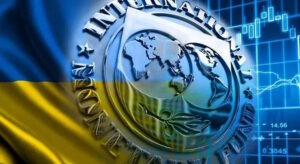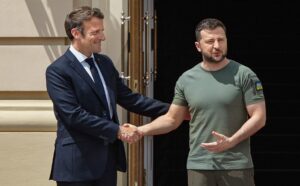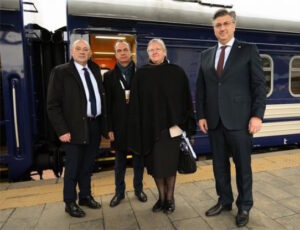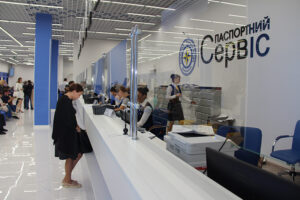
The board of directors of the International Monetary Fund (IMF) on Friday approved a four-year, SDR11.6 billion ($15.6 billion) extended EFF program as part of a total support package for Ukraine of $115 billion, the Fund said in a statement.
“The Ukraine program (for 2023-2027), supported by the EFF, aims to anchor policies to maintain fiscal, external, price and financial stability and support economic recovery, while improving governance and strengthening institutions to promote long-term growth in the context of post-war recovery and Ukraine’s path to the EU,” the IMF said.
The Fund specified that the decision of the board of directors allows for immediate disbursement of about SDR2 billion (or $2.7 billion).
IMF mission chief Gavin Gray clarified to reporters that the first review of the program is expected in June-July this year, the second by the end of October, possibly in early November, and from 2024 will be quarterly.
According to the release, EFF approval is expected to attract large-scale concessional financing from international donors and Ukraine’s partners to help resolve Ukraine’s balance of payments problem, achieve medium-term external viability and restore debt sustainability on a prospective basis in both baseline and negative scenarios.
The IMF notes that in view of the exceptionally high uncertainty faced by Ukraine, the EFF program envisages a two-stage approach. In the first phase of the program, scheduled for 2023-2024, the focus will be on three goals. These include, among others, strengthening the 2023 budget and supporting revenue mobilization, including by avoiding new measures that could undermine tax revenues.
In addition, it is about sustainable disinflation and exchange rate stability, including by maintaining sufficient foreign exchange reserves, and promoting long-term financial stability, including by preparing a more in-depth assessment of the banking sector and further strengthening the independence of the central bank.
“Independent and effective anti-corruption institutions will help reduce corruption risks during martial law and build public and donor confidence in future reconstruction,” the Fund adds.
He also noted that the first phase of the program will protect social spending.
“The second phase of the program will shift the focus to more ambitious structural reforms to strengthen macroeconomic stability, support early post-war recovery, and enhance resilience and higher long-term growth, including in the context of Ukraine’s EU accession goals,” the IMF pointed out.
According to the release, Ukraine is expected to return to its pre-war policy fundamentals, mainly a flexible exchange rate and inflation targeting, while improving productivity and competitiveness, strengthening institutions and addressing financial and energy sector vulnerabilities.
In addition, fiscal policy will focus on critical structural reforms to guarantee medium-term revenues by implementing a national revenue strategy, along with improving public financial management and introducing public investment management reforms to support postwar recovery.
“The risks to the EFF program are exceptionally high. The success of the program depends on the size, composition and timing of concessional external financing to help close the budget deficit and external financing and restore debt sustainability on a forward-looking basis under baseline and negative scenarios,” said First Deputy Managing Director Gita Gopinath.
IMF Chief of Mission Gavin Gray specified that besides $15.6 billion from the Fund, the support package implies $80 billion from multilateral and bilateral donors, of which $20 billion in grants and $60 billion in concessional loans, as well as another $20 billion in deferred external debt payments.
According to him, the baseline scenario assumes the completion (winding down) of the war in mid-2024, while the negative scenario – by the end of 2025 with an increase in financing needs up to $240 billion.
At the same time, the IMF representative stressed that the program provides additional guarantees from a number of shareholders of the Fund, as preferred creditors, in particular the G7 countries, Belgium, Lithuania, the Netherlands, Poland, Slovakia and Spain.

Ukrainian President Volodymyr Zelensky reported about the hour-long conversation with his French counterpart Emmanuel Macron.
“In an hour-long conversation with Emmanuel Macron we substantially and effectively discussed the defense cooperation between Ukraine and France. Informed in detail about the situation on the front. We dwelled on the further steps for the implementation of the Peace Formula. Coordinated actions in the context of the nearest international events”, – reported in Telegram channel Zelensky on Saturday.

The population of EU countries will decrease by 6% by 2100, the EU statistical service Eurostat predicts. From January 1, 2022 to January 1, 2100, the number of residents in the EU will decrease by 27.3 million, to 420 million. At the same time in 2022, the population began to recover after a decline associated with the coronavirus.
According to preliminary data, 451 million people lived in the EU on January 1, 2023, compared to 443.2 million in 2021. Eurostat attributes the increase to the mass influx of Ukrainian refugees.
The maximum population – 453 million people – is expected in 2026.
In 2022-2100, the proportion of residents aged 0 to 19 years will decrease from 20% to 18%, and from 20 to 64 years – from 59% to 50%. The shares of residents aged 65-79 and older will increase from 15% to 17% and from 6% to 15%, respectively.
Preliminary data of the census for 2021 indicate an increase of the population compared to 2011 in 16 EU countries and a decrease – in 9. The most significant increase for 10 years showed Luxembourg (26%), Malta (24%) and Sweden (10%), reduction – Bulgaria (11%), Croatia (10%), Latvia (9%) and Lithuania (8%).
The leaders in the number of inhabitants in 2021 were Germany (83.2 million), France (67.9 million), Italy (59 million), Spain (47.4 million) and Poland (37 million).

Slovak Prime Minister Eduard Heger, Croatian Prime Minister Andrej Plenković and Slovenian Prime Minister Robert Golob have arrived in Kiev, where they will participate in a summit to mark the anniversary of the liberation of Buča. Slovak Prime Minister Heger arrived in Ukraine on Friday and will meet with President Vladimir Zelenski, the Slovakian news agency TASR reported.
Along with Heger, Slovak Defense Minister Jaroslav Nagy arrived in Ukraine. The time and place of the meeting are not disclosed in advance for security reasons.
According to Heger, Zelenski invited him to visit Ukraine in a telephone conversation after Slovakia approved the transfer of MiG-29 fighter jets to Ukraine.
For his part, Nagy is scheduled to meet with his Ukrainian counterpart Alexey Reznikov during the day.
In addition, Croatian Prime Minister Andrej Plenkovic arrived in Kyiv on Friday morning. He is scheduled to meet with Zelensky, Prime Minister Denis Shmygal and Chairman of the Verkhovna Rada Ruslan Stefanchuk. Also with the Croatian prime minister arrived Minister of Veterans Affairs Tomo Medved.
According to the Croatian government’s website, together with Zelenski, Heger, Golob and Moldovan President Maia Sandu, they will take part in a summit on “Bucha – Russian Responsibility for Crimes in Ukraine” in Kiev to mark the anniversary of the liberation of Bucha (Kiev region). A joint press conference will follow.
This is Plenkovic’s second visit to Ukraine since the Russian aggression began on February 24, 2022. Last May, he met with the Ukrainian leadership in Kiev and visited Irpen and Bucha.
The Slovenian newspaper Delo, for its part, reported on the arrival of Slovenian Prime Minister Robert Golob in Kiev on Friday. He also intends to meet with Zelenskyy.
For the Slovenian prime minister, this is his first visit to Ukraine since coming to power. His goal is to reaffirm his support for Ukraine, which has been a victim of Russian aggression since last February.
Golob will also be received by Shmygal and Stefančuk .

In the capital of Germany opens the first office of the state enterprise “Document”, where Ukrainian citizens will be able to issue passport documents.
“On Friday, March 31, a test mode of operation begins for citizens of Ukraine to obtain passport documents in Berlin at the address: Am Treptower Park 14, 12435 Berlin, floor 2”, – reported on the official website of SE “Document”.
During the period of operation in the test mode, visitors will be served from Monday to Saturday from 9.00 to 18.00 in the “waiting list”.
Reportedly, the full launch of the center will be additional notice on the official resources of SE “Document”. Until now Ukrainians had the opportunity to issue passports in Germany only through consular offices.
Now abroad passport services, where Ukrainian citizens can apply for a passport – foreign or ID-card, operate in Poland, Turkey, Slovakia and the Czech Republic.

Gas transit through Ukraine increased again after completing the usual weekend decline – to the standard level.
UKRAINIAN TRANSIT
“Ukraine’s GTS Operator (OGTSU) accepted a 42.4 million cubic meters transit request from Gazprom for Tuesday, the Ukrainian company said. The nomination for Monday was 40 million cubic meters. The capacity is claimed for only one of the two entry points into the country’s GTS, the Sudzha gas metering station. No bid was accepted for the corridor through the Sohranovka gas metering station.
EUROPEAN MARKET
Electricity generation from wind turbines in Europe last week already accounted for 21% of the region’s needs. Monday’s figure is roughly the same (20.8 percent), according to the WindEurope Association.
On Monday the price of gas rose by 4%. The day-ahead contract at the TTF hub in the Netherlands closed at $481 per thousand cubic meters.
The gap in LNG prices in Asia compared to Europe is noticeable. The May JKM Platts futures (Japan Korea Marker, reflecting the spot market value of cargoes shipped to Japan, South Korea, China and Taiwan) traded at $447; the North West Europe LNG futures (LNG North West Europe Marker) was $426.
RESERVES IN EUROPE
Europe’s current gas reserve level is 56.02%, 22 percentage points above the average for the same dates over the past five years, according to Gas Infrastructure Europe (GIE).
Gas reserves rose by a symbolic 0.05 percentage points on the weekend of March 26. The inventory build-up has continued for five days in a row.
European LNG receiving terminals operated at an average capacity of 63 percent in February and have been showing 66 percent utilization since early March. US STORAGE STOCK.
The state of U.S. UGS inventories is becoming increasingly important to the global market as the country actively ramps up exports.
During the next reporting week, reserves dropped by 2 bln cubic meters – a noticeable increase (60%) from the normal level at that time.
The current inventory level is 39%, 23 percentage points above the average for the last five years, according to the U.S. Department of Energy’s Energy Information Administration (EIA).
Freeport LNG, the largest U.S. LNG plant, has restarted all three liquefaction lines. This reduces the surplus gas in the U.S. market and increases global supply.